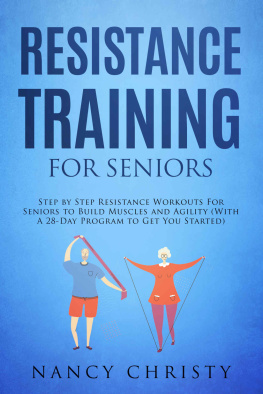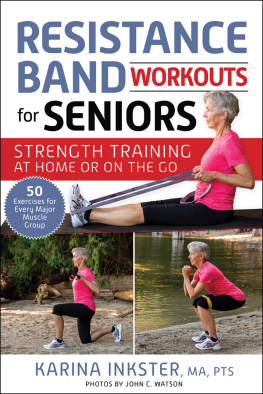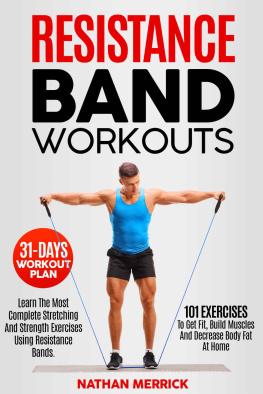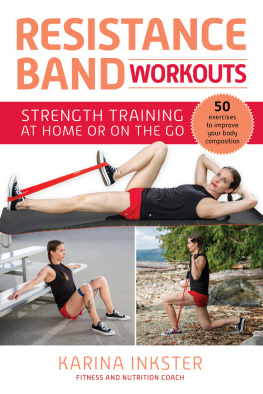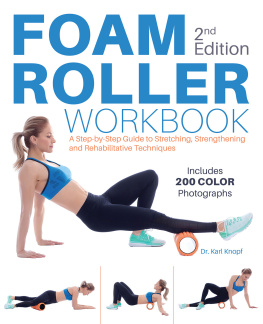KARL KNOPF is the author of ten books, including Core Strength for 50+, Kettlebells for 50+, Stretching for 50+, Foam Roller Workbook, Healthy Hips Handbook, Healthy Shoulder Handbook and Make the Pool Your Gym. He has been involved with the health and fitness of the disabled and older adults for nearly 40 years. A consultant on numerous National Institutes of Health grants, Knopf has served as advisor to the PBS exercise series Sit and Be Fit and to the State of California on disabilities issues. He is a frequent speaker at conferences and has written several textbooks and articles. Knopf coordinates the Fitness Therapist Program at Foothill College in Los Altos Hills, California, and is the director of senior fitness at the International Sports Sciences Association (ISSA).
Thanks to Peter Pipe for his modification of using a PVC tube as a handle. A special thanks goes to Lily Chou for sharing her insights and knowledge, which significantly improved the outcome of this book. Thanks also go out to the staff at Ulysses Press, whose support made this book possible. Additionally, a giant thank you to the models, Chris Knopf, Mary Gines and Toni Silver. Much appreciation also to the skilled photographic team at Rapt Productions. Lastly, a special thanks goes to my son Chris Knopf for his assistance with this book and to his mother Margaret for allowing me quiet time to work on this project when we couldve been doing something fun.
Welcome to the world of resistance bands! Resistance training bands were ranked with stability balls as the most popular piece of exercise equipment in a 2011 IDEA Personal Training Equipment Trends report. Resistance tubing and bands are popular because theyre lightweight and easy to transport, which means they can be used when traveling. Many trainers and therapists like the band because they can adapt any exercise to a functional application.
These latex training devices have been around since the 1970s, yet theyre a mainstay of almost every fitness enthusiast. Bands were first used in therapy to introduce low-intensity resistance to rehabilitating patients. Today bands come in all shapes and resistances and can be used by people of all ages and fitness levels.
Resistance Band Workbook features almost every conceivable exercise ever done with an exercise band. Whether youre looking to enhance your physique, elevate your sports performance or simply improve functional fitness, this book will add a new dimension to your workoutregardless of your experience level with resistance training.
Chances are youre familiar with the term strength training. You might also know aboutand even performweightlifting, weight training, resistance training or progressive resistance exercise. Simply put, these terms are used interchangeably by the public to describe the act of harnessing a resistance to place a load/strain on a muscle to develop muscle or improve muscular endurance.
Strength training can take many forms, from lifting your own body against the resistance of gravity to using weights or exercise bands to challenge your muscles. It really doesnt matter what shape or form the resistance comes in because the ultimate goal is to improve strength, muscle size (hypertrophy), muscular endurance or power.
The best method to improve strength is often referred to as progressive resistance exercise training. Here, a person engages in a set of exercises that slowly and progressively overload a muscle. When the muscle adapts to the challenge of a load/resistance and the resistance becomes easier, the person either increases the resistance/load or performs more repetitions. The general rule of thumb is when you can perform 1015 reps easily and correctly, you need to increase the load. In weight training you increase the weight, but in resistance band training you progress to the next harder band or combine two bands together.
As you improve in strength, its advised to increase the volume of work you perform by adding sets to your workout. Two to three sets of each exercise are ideal.
The adaptability and versatility of resistance training bands make them suitable for all levels, from those recovering from injury to world-class athletes. In addition, the beauty of performing resistance band training is that you dont need to buy or store heavy equipment or drive to a gym. Every exercise that can be done on a piece of exercise equipment or with weights can be done with an exercise band.
There may be even more opportunities with band training than with weight training. The bands come in varying resistances, so as you get stronger you can purchase heavier-resistance bands in order to accommodate your improvements in strength. They can be easily and quickly exchanged to increase or decrease the resistance depending upon the exercise. You can also exercise a muscle at various angles as well as both eccentrically and concentrically. A total-body resistance band workout should take less than 15 minutes and can be done practically anywhereeven in the pool.
Here are additional benefits of training with bands:
Increased strength in muscles and bones
Improved balance
Reduced lower back pain
Improved blood sugar control
Improved blood transport system
Increased metabolism
Reduced arthritic pain
Just keep in mind that exercise bands alone will not offer great changes in muscular hypertrophy, or massive muscle development, but for most people band training provides adequate results. The band is versatile and convenient, and it tones the muscles with low risk of injury. However, be aware that you may compromise the quality of your training by incorrectly placing your hands on the bands or allowing the band to control the movement.
Resistance bands are typically made of latex and come in several shapes and intensities. Theyre commercially available at most sporting goods stores and therapy outlets and through online vendors. Selecting the correct band for your goals and body type is critical for obtaining ideal results. Ultimately, through personal trial and error youll determine which shape and style works best for you and your objective.
Today manufacturers produce exercise bands that accommodate every level of ability. Depending on the manufacturer, the color of the band generally denotes the intensity. Usually a light color such as pink and yellow is the easiest resistance, green and red moderate and dark gray and black very intense. However, please keep in mind that no standards exist between band manufacturers (one manufacturers pink band may be much harder than another manufacturers pink band) so select the band you use based on how it feels rather than the color.
There are basically two forms of resistance bands: flat and tubular. The flat one is the most common and is available latex-free for those with a latex allergy. Sometimes bands come in rolls and can be cut for specific purposes; they can also be purchased pre-cut. Most exercises can be completed with a three- to six-foot piece of band; you can choke up on the band to make it fit your needs. If youve never used bands before, start with the flat band and progress from there.
The tubular version is becoming more popular because its more durable and comes with padded handles. You may even find tubing with adjustable handles in order to adapt the length of the tubing to the individual. However, you can purchase handles for the flat variety. Wrapping the flat band around a small piece of PVC pipe can also provide a wonderful handle. Some resistance training bands are loops that can be wrapped around your limbs to provide additional challenges. You may also come across a figure eight-shaped exercise band, an exercise bar and a braided exercise tube. Some of these bands can be attached to free weights to increase resistance, which introduces additional training elements to an exercise, such as improving control and decreasing unwanted momentum in explosive maneuvers.


